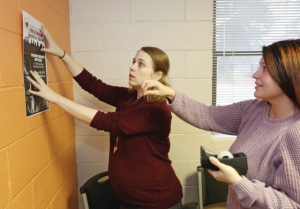Counting homeless in county
By Phyllis Moore
Published in News on January 11, 2015 1:50 AM

News-Argus/MELISSA KEY
Michele Wiggins, compliance manager at the Goldsboro Housing Authority, left, and Kacie Baker, a WCC student, hang a poster for Point in Time Count to determine how many homeless people are in Wayne County.
Wayne County agencies are leading an effort to get a count of how many homeless people live in the county -- as part of an effort to get more resources to help them.
"The Point In Time Count" is an annual nationwide initiative for HUD, the U.S. Department of Housing and Urban Development that asks for the homeless, sheltered and unsheltered, to be counted during one 24-hour period.
This year will be Wayne County's first time participating in the effort.
Kacie Baker, a human services student at Wayne Community College, was looking for a service learning project and was chosen to be team leader for the local Point in Time Count. She was paired with Michele Wiggins of the Goldsboro Housing Authority, compliance manager for the project.
"We were approached about helping with the opportunity just because I think Eastpointe has expanded a lot," Ms. Wiggins said. "We agreed to partner with Eastpointe and the co-op program work-based learning (at WCC).
"We just want to make it as good of an event as possible. There are a lot of agencies in this community who will benefit."
HUD requires a count each year during the last 10 days of January. The one-day event encourages communities to determine where homeless are on that particular night, whether in emergency shelters and transitional housing or in places like soup kitchens and other sites.
Wayne County's event will be held on Jan. 28 from 3 to 8 p.m. at the Community Soup Kitchen. In addition to the count itself, the goal is to provide on-site services such as health screenings, information and referrals to community resources.
There are several ways the count will be administered. The 24-hour period will be 3 p.m. Jan. 28 through Jan. 29. Those at the Community Soup Kitchen will be counted for that day, while other sites such as shelters or known gathering places for the homeless will also be visited.
"One of the biggest reasons we're doing this is we want it to be accurate," Ms. Wiggins said. "We want people to become interested in attacking the problem, admitting that there's a problem."
Several agencies have already been contacted, such as the Salvation Army and some health care offices. Others are encouraged to come on board, and volunteers are also needed.
"On the 28th, the day of the event, we need people to volunteer to help to distribute surveys, help fill out the surveys," she said. "We do demographic surveys, basic information, they don't even include names. The surveys will be collected and tabulated and combined for one report to HUD."
The local effort will end up being a count for Lenoir, Sampson, Duplin and Wayne counties.
Ms. Baker said advance training for volunteers will be provided.
"Two weeks before the event, we'll have two nights of training here at the college, Jan. 14 and 15, 5:30 to 6:30 p.m. in the Walnut Building," she said. "They only have to come to one meeting. We'll go over the history, what to expect at the event, what we're needing help with."
Volunteers must be 18 and older and can sign up to serve for one or two hours or for the entire event.
"Anyone that thinks they have something to offer to the homeless population if they serve them -- service providers and agencies -- if they have information for them, we would like for them to come and support it," Ms. Baker said.
"We know a lot of them cannot provide services on the day of the event," Ms. Wiggins added. "We'll have a combination of services provided and information about services to be provided."
There is also a concern about some homeless who might not frequent some of the typical programs like the soup kitchen. Organizers of the event are seeking ways to get the word out to that segment as well.
"If you know someone who is homeless, areas where they congregate, we're not trying to disrupt their lives in any way," Ms. Wiggins said.
The more accurate the count, the better, she explained.
"We're still only going to get a percentage of the money," she said. "Some of the numbers have been horribly off in the past. The numbers may have been reported at such a low rate that haven't represented people, making (others) think there's no need locally."
The gap has made it challenging to provide services, such as emergency housing, she said. If numbers are lower than the actual count, some agencies could be affected by reduced funding.
For information about the upcoming events or to volunteer, contact Ms. Baker at 919-722-9905 or Kmbaker3176@student.waynecc.edu.
